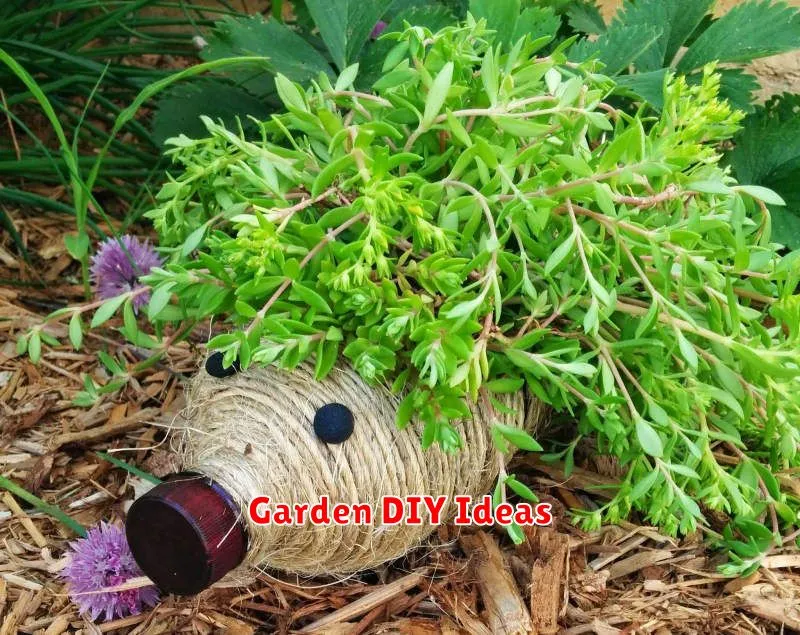Transform your outdoor space into a haven of beauty and charm with our Top 10 DIY Garden Decor Projects. This collection showcases inspiring and easy-to-follow tutorials for creating stunning garden decorations using readily available materials. Whether you’re a seasoned gardener or a complete beginner, these DIY projects offer a fantastic opportunity to personalize your garden, boost your creativity, and add significant curb appeal without breaking the bank. Discover clever ideas for upcycled garden art, practical DIY garden planters, and enchanting outdoor lighting solutions that will leave your neighbors green with envy. Let’s embark on this rewarding journey of crafting unique and beautiful garden décor together!
Recycled Tire Planters
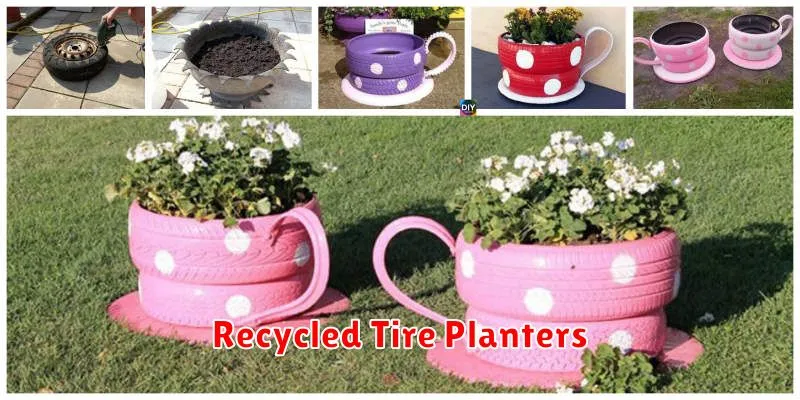
Recycled tire planters offer a unique and sustainable way to enhance your garden or landscape. Transforming discarded tires into attractive and functional containers provides an eco-friendly alternative to traditional planters while adding a touch of rustic charm.
The process of creating these planters is relatively straightforward, though it requires some preparation and the right tools. Safety precautions are paramount, as working with tires can involve sharp edges and potential hazards. Appropriate protective gear, including gloves and eye protection, is essential.
Several methods exist for crafting tire planters. One popular technique involves cutting the tire to create a desired shape, such as a flower bed or a vertical planter. Another approach focuses on painting and decorating the tire to personalize its aesthetic appeal. The level of customization is entirely dependent on personal preference and creativity. Adding additional features such as decorative elements or even small integrated drainage systems can enhance both the functionality and visual appeal.
The use of recycled tires as planters promotes environmental responsibility by diverting waste from landfills. This sustainable approach reduces the environmental impact associated with the production and disposal of traditional planters, contributing to a greener lifestyle. Furthermore, the durability of tires ensures the planters’ longevity, offering a long-term solution for your gardening needs. The robust nature of these planters makes them suitable for a variety of planting options, from flowers and herbs to vegetables and other flora.
In conclusion, recycled tire planters present a compelling combination of sustainability, practicality, and aesthetic appeal. Their creation offers a fulfilling DIY project with significant environmental benefits. The relatively low cost and ease of construction make them an accessible option for gardeners of all levels of experience, making them a truly versatile and eco-conscious choice.
Hand-Painted Garden Rocks
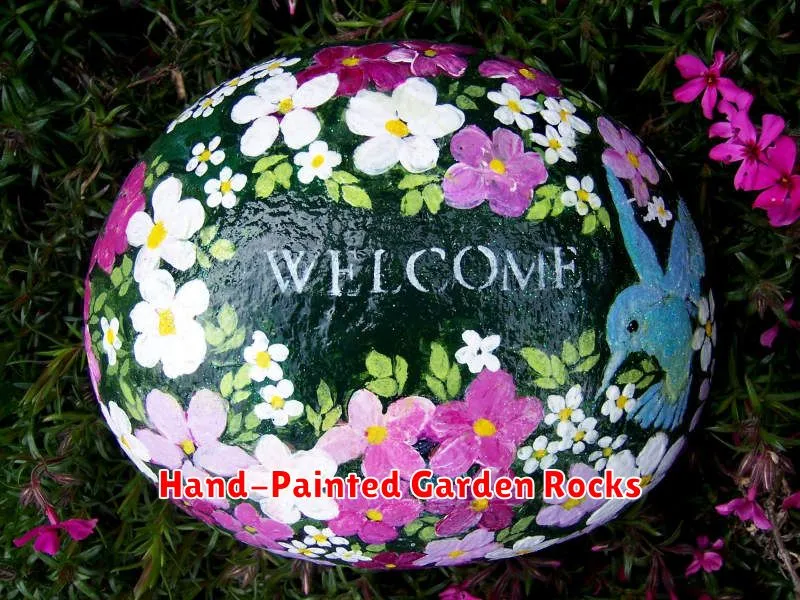
Hand-painted garden rocks offer a charming and affordable way to personalize and enhance any outdoor space. These decorative stones can add a unique touch to gardens, pathways, or even indoor plant displays. The creative possibilities are virtually endless, allowing for a wide range of artistic expression.
The process of creating these artistic pieces is surprisingly simple. Begin by selecting smooth, naturally occurring stones of varying sizes and shapes. Cleaning the stones thoroughly is crucial to ensure the paint adheres properly. A simple scrub with soap and water, followed by a thorough drying, prepares the surface for painting.
Choosing the right paints is vital for achieving a durable and long-lasting finish. Acrylic paints are a popular choice due to their vibrant colors, quick drying time, and weather resistance. Alternatively, outdoor-rated enamel paints provide exceptional durability, especially in harsh weather conditions. Consider using a sealant once the paint is dry to further protect the design and extend its lifespan.
Design inspiration can come from anywhere. Simple patterns, intricate designs, or even inspirational quotes can be skillfully incorporated onto the rocks. Using stencils can be helpful for creating crisp lines and consistent designs, while freehand painting allows for a more organic and expressive approach. The artist’s imagination is the only limit.
Once completed, the hand-painted garden rocks can be arranged to create a visually appealing display. They can be strategically placed among plants, lining pathways, or even used as unique markers in a garden bed. These artistic additions add a touch of personality and visual interest to any outdoor setting, transforming a simple landscape into a personalized work of art.
Beyond their aesthetic appeal, hand-painted garden rocks offer a rewarding and engaging activity for individuals of all ages. It provides a creative outlet, encourages artistic exploration, and results in beautiful, lasting decorations for the garden or home. The process is both relaxing and satisfying, producing unique pieces of art that enhance the beauty of one’s surroundings.
DIY Wooden Planters
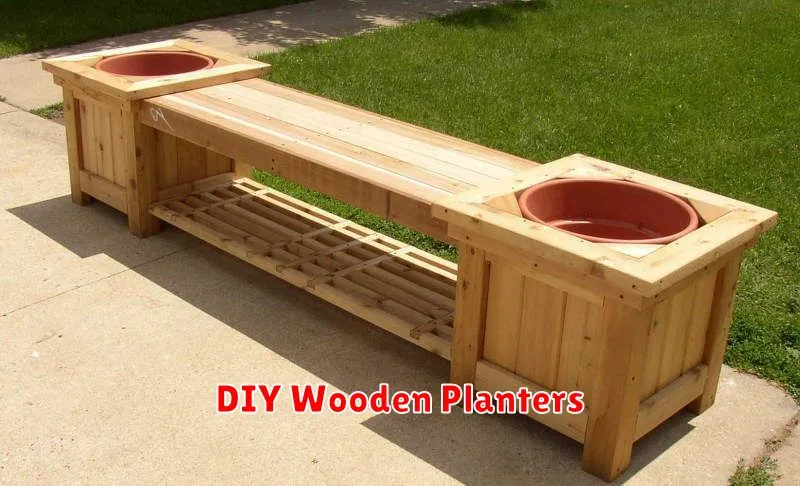
Creating your own wooden planters is a rewarding and relatively simple project, perfect for gardeners of all skill levels. This allows for complete customization in terms of size, shape, and style to perfectly complement your existing garden design and décor.
The first step involves selecting your wood. Cedar and redwood are excellent choices due to their natural resistance to rot and decay, ensuring a longer lifespan for your planter. Pressure-treated lumber is also an option, but ensure it is specifically treated for ground contact to avoid leaching chemicals into your soil. Consider the dimensions carefully; plan the size of your planter based on the plants you intend to cultivate.
Next, you’ll need to cut the wood to the desired size. Accurate measurements are crucial for a well-fitting planter. A miter saw or a hand saw can be used, depending on your comfort level and the complexity of the design. Once the pieces are cut, you’ll need to assemble them. Wood glue and screws are typically used for this purpose, providing a strong and durable bond. Pre-drilling pilot holes will help prevent the wood from splitting during assembly.
After assembly, consider adding a layer of waterproof sealant. This protects the wood from moisture damage and extends its longevity. Allow the sealant to dry completely before adding soil and plants. For added aesthetic appeal, you could consider staining or painting the planter. Choose a stain or paint that is suitable for exterior use and complements your garden’s overall aesthetic.
Finally, fill your newly constructed wooden planter with high-quality potting soil and plant your chosen flowers, herbs, or vegetables. Remember to provide adequate drainage holes in the bottom to prevent waterlogging. Enjoy the fruits (or vegetables!) of your labor and the satisfaction of creating a beautiful and functional addition to your outdoor space.
Hanging Mason Jar Lanterns
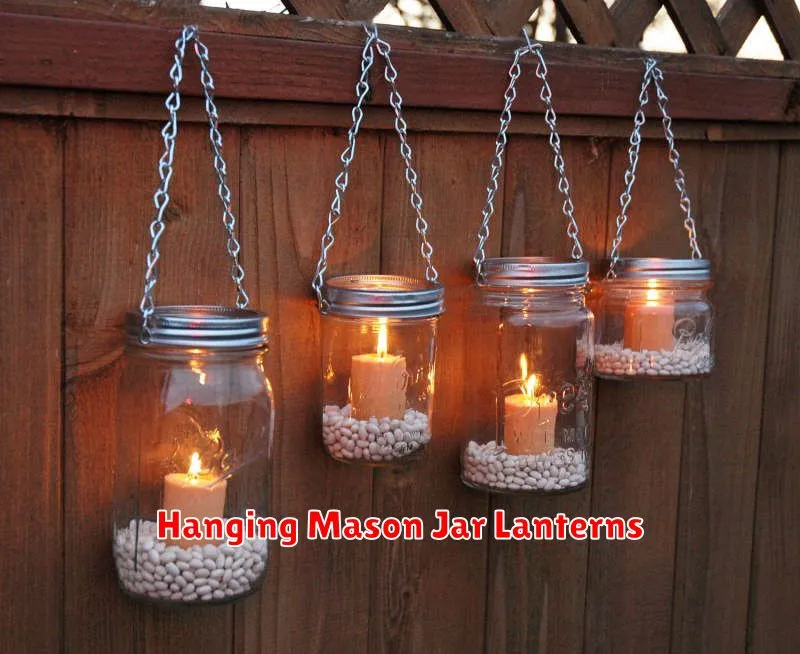
Mason jar lanterns offer a charming and versatile way to illuminate any space, from rustic outdoor settings to elegant indoor gatherings. Their simple yet elegant design makes them adaptable to a wide range of aesthetics.
The durability of mason jars is a key advantage. Made from sturdy glass, they can withstand various weather conditions, making them perfect for outdoor use. This robustness ensures longevity, providing a cost-effective lighting solution for years to come.
Creating a hanging mason jar lantern is a relatively straightforward process. Numerous tutorials and instructions are available online, guiding you through the steps involved in preparing the jar, selecting the appropriate lighting source (such as battery-operated tea lights or LED candles), and securely attaching the hanging mechanism. The customization possibilities are extensive.
Personalization is a significant draw. The jars can be decorated to match any theme or occasion. Adding paint, ribbon, lace, or other decorative elements transforms a simple jar into a unique and personalized lantern. This allows for creative expression and perfectly complements individual tastes and preferences.
Beyond their aesthetic appeal, safety should be a primary consideration. When using candles, ensure the lantern is placed on a heat-resistant surface and away from flammable materials. For outdoor use, consider weather-resistant options to prevent damage or malfunction.
In conclusion, hanging mason jar lanterns provide a cost-effective, customizable, and charming lighting solution for a variety of settings. Their durability and adaptability make them a popular choice for both casual and formal occasions.
Pallet Garden Shelves
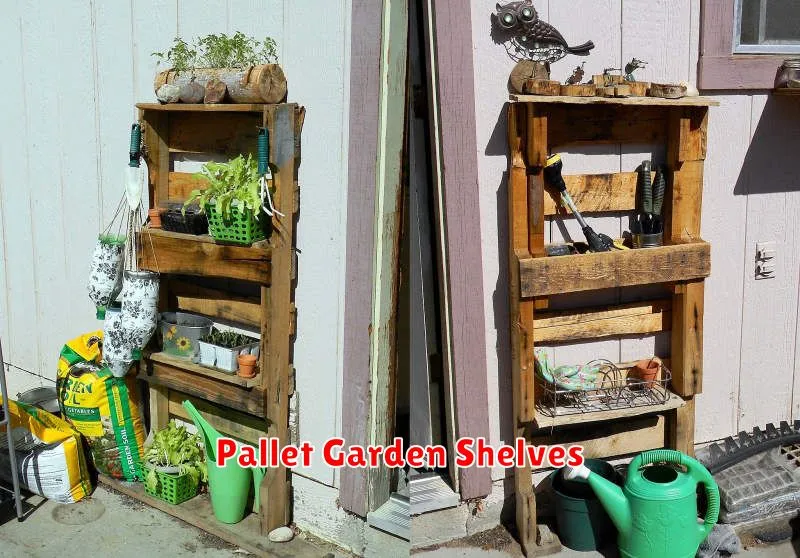
Transforming old shipping pallets into beautiful and functional garden shelves is a fantastic way to add rustic charm to your outdoor space while being environmentally friendly. This project is surprisingly easy and requires minimal tools and materials, making it perfect for DIY enthusiasts of all skill levels.
The first step involves cleaning the pallet thoroughly. Remove any loose nails or splinters and scrub down the wood to remove dirt, debris, and any potential pest infestations. Allow the pallet to dry completely before proceeding.
Next, consider sanding the pallet to smooth out any rough edges and splinters for safety and a more polished look. You can then decide whether to leave the wood in its natural state or apply a protective sealant or paint. A weather-resistant sealant is recommended for outdoor use to protect the shelves from the elements and extend their lifespan.
Once the pallet is prepared, you can start assembling the shelves. This may involve adding extra supports or shelves depending on the size and condition of the pallet. You can use brackets or additional wooden pieces to create sturdy and even shelves. Ensure all added components are securely attached using appropriate screws and/or nails.
Finally, it’s time to decorate and personalize your new pallet garden shelves! Add your favorite plants, flowers, herbs, and decorative items to create a vibrant and unique display. The rustic texture of the pallet complements a wide variety of plants and gardening styles, allowing for considerable creative freedom.
Creating pallet garden shelves offers a rewarding DIY project that combines practicality and aesthetic appeal. With minimal effort and cost, you can transform discarded materials into a functional and beautiful addition to your garden, adding a touch of rustic charm to your outdoor living space.
Upcycled Furniture as Garden Decor
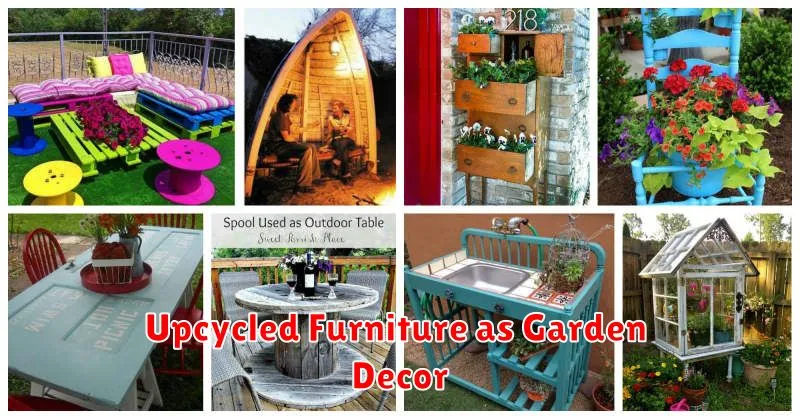
Give your garden a unique and charming touch by incorporating upcycled furniture. Instead of discarding old, worn-out pieces, repurpose them into stunning garden decorations. This eco-friendly approach adds character and personality to your outdoor space while promoting sustainability.
Old chairs can be transformed into whimsical planters, their seats filled with vibrant flowers or herbs. A worn-out dresser can become a charming potting bench, offering ample storage for gardening tools and supplies. Even broken pieces can be creatively incorporated; imagine a broken chair leg as a unique plant stand or a salvaged door as a rustic garden gate.
The possibilities are truly endless. Creative painting and distressing techniques can further enhance the aesthetic appeal. Consider using weather-resistant paints and sealants to ensure the longevity of your upcycled furniture in the outdoor environment. Adding a coat of protective varnish will also help preserve the wood.
Upcycling furniture is not only a cost-effective way to beautify your garden but also a rewarding project. It allows you to express your creativity and add a personal touch to your outdoor oasis. The process of transforming old furniture into something new and useful is incredibly satisfying and contributes to a more sustainable lifestyle.
So, explore your local thrift stores, antique shops, and even your own garage for potential upcycling candidates. With a little imagination and effort, you can create truly unique and captivating garden decor from discarded furniture, breathing new life into old pieces and adding a touch of rustic charm to your garden.
Bottle Cap Wind Chimes
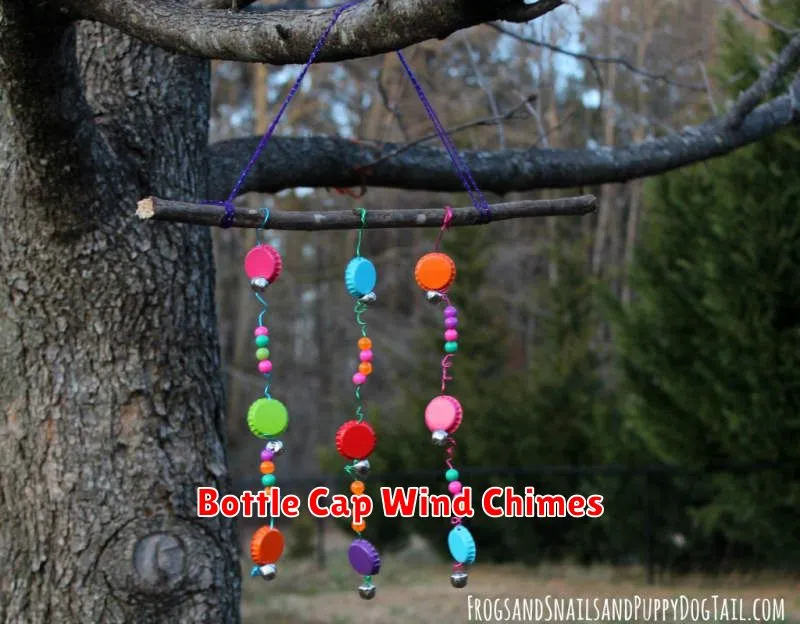
Create a unique and eco-friendly wind chime using recycled materials! This project is perfect for a rainy afternoon craft session, and it’s a great way to upcycle bottle caps you might otherwise throw away.
Materials you’ll need: A variety of bottle caps (different sizes and colors add visual interest!), strong string or fishing line, a sturdy piece of wood or metal for the top piece, scissors, optional: beads or other decorative elements.
Instructions:
-
Clean the bottle caps: Wash and thoroughly dry your bottle caps. Remove any remaining labels or sticky residue.
-
Prepare the string: Cut several lengths of string, each long enough to hang a bottle cap and reach the top piece. The length will determine the chime’s overall length.
-
Attach the bottle caps: Tie a knot at one end of each string. Securely tie the other end to the center of a bottle cap, making sure the knot is snug. Repeat for all bottle caps.
-
Assemble the wind chime: Gather the strings together at the top, leaving a small loop. Secure the strings tightly to your chosen top piece of wood or metal, using strong glue or wire.
-
Add decorative elements (optional): Enhance your wind chime by adding beads or other small decorative elements to the strings between the bottle caps.
-
Hang and enjoy! Find a suitable spot to hang your new recycled wind chime and enjoy the gentle sounds it makes in the breeze.
This project is a fantastic way to reduce waste and create a personalized piece of home décor. Feel free to experiment with different materials and designs to make your wind chime truly unique!
Miniature Fairy Gardens
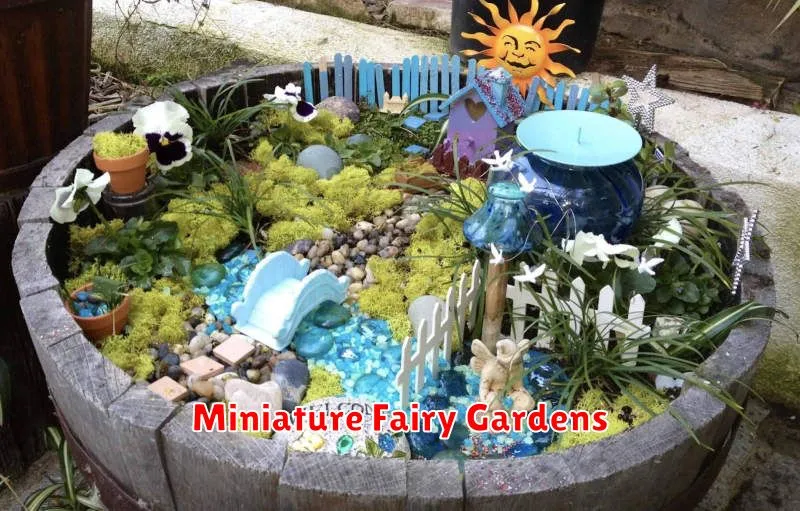
Creating a miniature fairy garden is a delightful and creative hobby that allows you to unleash your imagination and build a whimsical world in miniature. These enchanting gardens are perfect for adding a touch of magic to your patio, balcony, or even indoors.
The beauty of fairy gardens lies in their versatility. You can construct them in various containers, from repurposed teacups and terracotta pots to elaborate, multi-tiered structures. The size and complexity are entirely up to your preference and available space. Creativity is key; there are no strict rules!
Gathering materials is half the fun. Look for miniature figurines, such as fairies, gnomes, and animals. You can also incorporate small plants, rocks, pebbles, moss, and even bits of driftwood or bark to add texture and interest. Consider using miniature furniture, tiny houses, or whimsical accessories to complete your scene. Thrift stores and craft shops are excellent resources for finding unique treasures.
The design process is where you can truly let your personality shine. Think about the overall theme you want to create—a whimsical forest, a charming cottage garden, or a mystical enchanted realm. Arrange your elements carefully, considering scale, color, and texture. Remember to leave space for plants to grow and flourish.
Maintenance is relatively low, especially if you choose hardy, low-maintenance plants suitable for your climate and the amount of sunlight your garden receives. Regular watering is essential, but be mindful not to overwater, which can damage the miniature plants. Periodically check for weeds and remove any debris to maintain the garden’s aesthetic appeal.
Ultimately, building a miniature fairy garden is a rewarding experience that combines artistry, horticulture, and a touch of whimsy. It’s a project that can be enjoyed by people of all ages and skill levels. So, gather your materials and let your imagination run wild—your own enchanted realm awaits!
Birdhouses from Recycled Materials
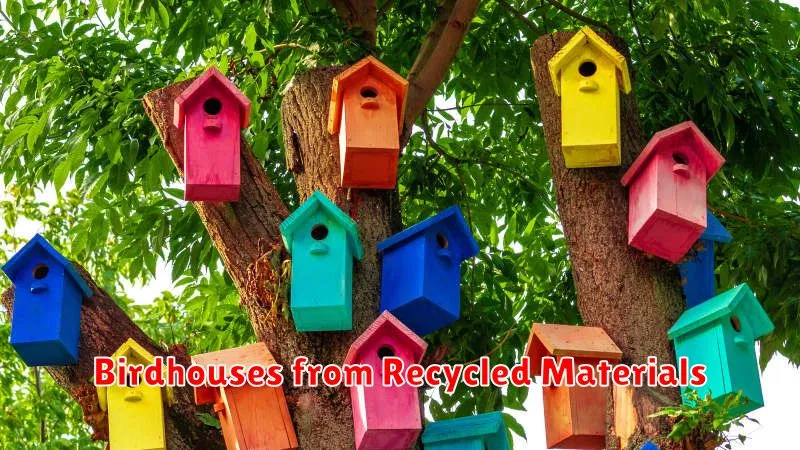
Building birdhouses is a rewarding hobby that can benefit both you and your feathered friends. But why buy new materials when you can create beautiful and functional homes for birds using recycled materials? This environmentally friendly approach allows for creative expression while minimizing waste.
Common recycled materials readily available for crafting birdhouses include reclaimed wood, such as old pallets or fence posts. These offer a rustic charm and a durable structure. Remember to thoroughly clean and sand any reclaimed wood to remove splinters and ensure the safety of the birds. Milk jugs, cleaned and cut carefully, can also be utilized to create unique birdhouse designs.
Tin cans, after proper cleaning and preparation (removing sharp edges!), can be painted and adapted into small, charming birdhouses. Plastic bottles, especially larger ones, offer another option, providing ample space for nesting. Remember to ensure adequate ventilation and drainage in any design you choose.
The creative possibilities are endless! You can add decorative elements using recycled buttons, bottle caps, or even broken pottery. The key is to create a safe and comfortable environment for the birds, focusing on proper ventilation, drainage, and a secure entrance hole. Remember to consider the size of the entrance hole based on the type of bird you intend to attract.
Building birdhouses from recycled materials is not only a sustainable practice but also a fun and engaging activity. It allows you to express your creativity while contributing to a healthier environment. So gather your recycled materials and start building—you’ll be surprised at the charming and functional birdhouses you can create!
DIY Garden Signs
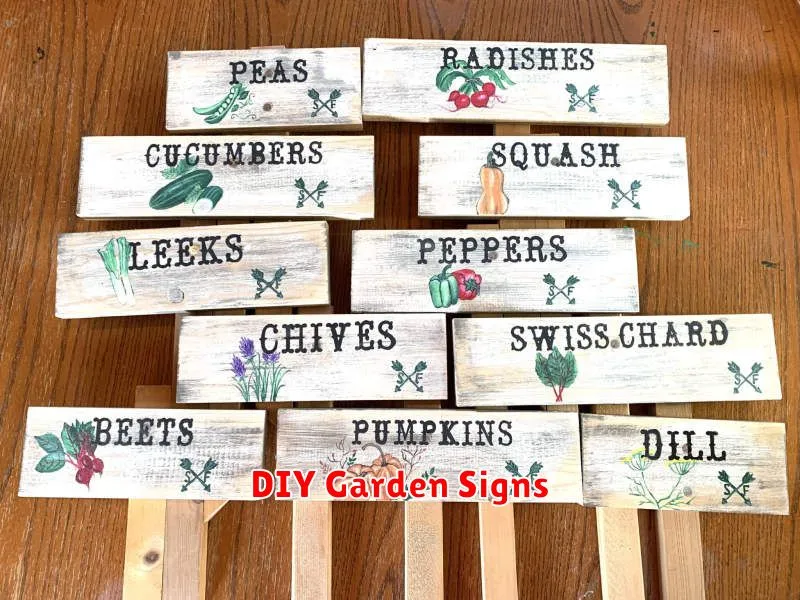
Creating your own garden signs is a fun and rewarding project! It allows you to personalize your outdoor space with unique and charming decorations. The possibilities are endless, from simple markers for herbs and vegetables to elaborate welcome signs for your entire garden. This guide will walk you through some easy and creative ways to make DIY garden signs.
Choosing Your Materials
The best materials for your signs will depend on your desired style and the durability you need. For a rustic look, consider using reclaimed wood, driftwood, or even old window frames. These materials offer a natural, weathered aesthetic. If you prefer a cleaner look, smooth wood, metal sheets, or even slate are excellent options.
Designing Your Sign
Before you start crafting, sketch out your design. Consider the size and shape of your sign. Think about the font you’ll use for your text and any additional decorations you might want to add. Simple designs are often the most effective, so don’t feel pressured to make something overly complex.
Crafting Your Sign
Once you have your design, it’s time to bring it to life! If you’re using wood, you may need to sand it down and apply a sealer to protect it from the elements. For painting, choose weatherproof paint in vibrant colors that complement your garden. You can use stencils, freehand painting, or even decoupage techniques to add your text and images. For metal signs, you might consider using enamel paint for a durable finish. Remember to let your paint dry completely before displaying your sign.
Adding Finishing Touches
To enhance the overall look and durability of your sign, consider adding finishing touches. A coat of varnish or sealant will protect your sign from rain and sun. You can also embellish it with decorative elements like ribbons, small plants, or even mosaic tiles. Once everything is in place, you can then securely mount your garden sign in its desired location using appropriate hardware.
Ideas for Garden Signs
Get creative! Here are some ideas to get you started: Herb labels, vegetable markers, welcome signs, funny quotes, seasonal greetings, and directions to different areas of your garden.

